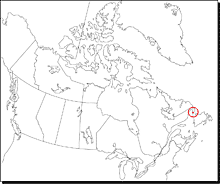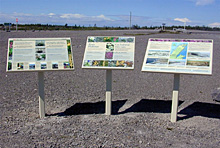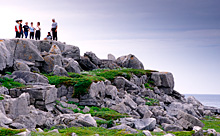A cooperative, ecosystem approach to protecting rare plants
A little beauty on the barrens

The tiny Fernald’s braya (a mustard species known by the scientific name of Braya fernaldii) grows nowhere in the world but on the coastal limestone barrens of northwestern Newfoundland. It is a hardy plant just a few centimetres tall, with small white flowers at the end of a stem growing from a ring of leaves at the surface of the gravelly soil. Left alone in the wild, it withstands the frequent heaving and churning of the gravel as the barrens freeze and thaw.
Fernald’s braya is however vulnerable to any activity that alters its habitat– like gravel extraction, burial under piles of material, or vehicle traffic. This is one of the reasons why the tiny perennial has been designated threatened under the Species at Risk Act (SARA). Others include low numbers and limited populations. The good news for Fernald’s braya is that the local people are getting to know and love the barrens. Moreover, they’re helping to protect the rare plants in the process.
Reaching out to local people

For Parks Canada, introducing local people to the beauties of the barrens is a priority. Part of the limestone barrens is within Port au Choix National Historic Site. About 25% of the world’s population of Fernald’s braya grows at Port au Choix. This means that as the historic site’s manager, we must protect this habitat and the Fernald’s braya to help recover their numbers.
Through the national recovery team, many organizations were already involved in braya research and recovery work. Provincial biologists and university researchers were studying the plants to better understand their ecological requirements and life cycle in order to develop conservation, restoration or even ex-situ preservation strategies.

We recognized that the biggest threat to the barrens was a lack of public awareness and concern. Most people viewed the barrens as a wasteland, and a source of gravel. They quarried gravel, stored their fishing nets, dumped trash, and drove on them without knowing the consequences for rare plants. This was a place where we could help.
Learning to love the barrens
We did not work alone. By co-ordinating our efforts with those of the scientific partners on the recovery team, and supporting an ecosystem-wide initiative, we have collectively made a difference throughout the 300 km braya range, from Port au Choix to Cape Norman at the tip of the peninsula. With funding from the Habitat Stewardship Program, Parks Canada interpretation staff trained a local stewardship co-ordinator, and worked to engage the communities who use the barrens. Many different tools were developed: posters about the wildflowers of the barrens, school and youth ambassadors programs, a website and a field guide to the barrens, and even sponsored art workshops and tours.

With help from the Species at Risk Recovery Action and Education Fund, Parks Canada erected interpretive signs at Port au Choix, introducing the limestone barrens, explaining why they are special, and encouraging people to enjoy them responsibly. We hired local resident Shirley Alyward to interpret the site’s natural history. She tells visitors all about the barrens and helps researchers and students working at the site. In addition, she keeps a close watch on the rare plants.
"Keep out" is not the message
The historic site is there for people to enjoy, so visitors are encouraged to come and see the barrens. It’s all about strengthening a connection to the place.
We paid particular attention to the needs of fishermen who need to cross the barrens to retrieve gear along the shoreline, or check on ice conditions. By finding mutually acceptable solutions, we gained allies in our conservation efforts.
Today, success is apparent. More and more people are opting for activities compatible with conservation of the barrens such as walking. A recent attitude survey shows that public awareness is growing. ATV traffic, while not totally curtailed, is no longer condoned. And the historic site is more popular than ever with a wider range of visitors. As never before, schools and naturalist groups have been calling to arrange tours.

Forging a connection
This is great news both for the cultural heritage of Port au Choix and the ecological integrity of the barrens. Local people support the conservation of the limestone barrens, Fernald’s Braya and other rare plants. This is one of the things Parks Canada does best, working with partners to achieve a longer term goal.
File(s)
Printable version: "A Little Beauty on the Barrens" (PDF, 3.42 MB)
- Date modified :